New Jersey Devils: Top 10 Prospects Entering the 2018 Season

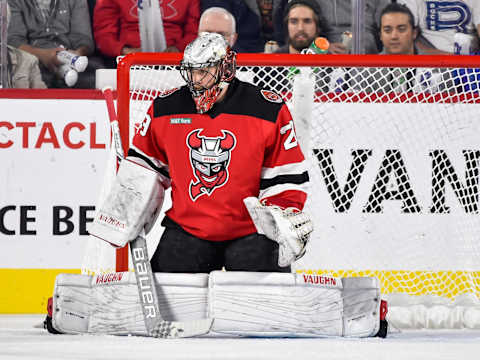
The New Jersey Devils are building a contender after making the playoffs on the back of Hart trophy winner Taylor Hall in 2018. Here are ten prospects who can keep the Devils in contention into the future.
The New Jersey Devils are a team that benefitted from an excellent player in 2017-18. Taylor Hall won the Hart trophy, pushing the Devils into the playoffs. Now, the Devils need to build a team around Hall, one that will be capable of making the playoffs year after year. That means building around the young core, which is more than just Hall.
That’s where the prospects come in. These prospects are ranked based on three equal factors: ceiling, NHL readiness, and the likelihood the prospect plays consistently with the New Jersey Devils in the future. To qualify, these prospects need to have not played 25 NHL games, thus being eligible for the Calder trophy.
Let’s start with the goaltenders.
1. Mackenzie Blackwood [21] (2-42, 2015)
Stats (Binghamton Devils, AHL): 32 games played, 3.41 goals against average, .882 save percentage, 2 shutouts; 5 gp, 2.48 GAA, .920 SV% (5 playoff games played, 1.00 GAA, .964 SV%, 1 SO). Adirondack Thunder, ECHL
Mackenzie Blackwood has not spent as much time in the AHL as the New Jersey Devils would likely hope. Behind two goaltenders in the AHL for the longest time (Scott Wedgewood and Ken Appleby), Blackwood was forced into the ECHL last year and then again this season.
The Devils still have Schneider, but they will need another franchise goaltender to eventually replace him. That should be Blackwood.
Now, with fewer obstacles to his professional development, Blackwood should get serious time in the AHL. That’s not to say he didn’t do well in the ECHL, but his success there and need for improvement in the AHL shows he needs to play in a better league. Blackwood’s struggle in the AHL is not necessarily a bad thing, either. The Binghamton Devils didn’t have the greatest defense this past season, and that should change. His two shutouts and .882 save percentage in his first extended stretch show potential.
Blackwood is also still very young and has time to improve in the AHL. If he gets to a .900 save percentage this season, Blackwood will show significant signs of eventually reaching the NHL. The Devils still have Cory Schneider, but they will need another franchise goaltender to eventually replace him. That should be Blackwood.
2. Cam Johnson [24] (UDFA)
Stats (University of North Dakota, NCAA): 29 gp, 2.14 GAA, .910 SV%, 3 SO; 3 gp, 3.90 GAA, .876 SV%. Binghamton Devils, AHL
Cam Johnson did very well in the NCAA this past season, even with a lesser team in front of him at the University of North Dakota. He was tied for 19th with three shutouts, 36th with a .910 save percentage, and was 16th with a 2.14 goals against average. Johnson made a professional transition with three games in the AHL, though he didn’t perform… ideally.
At 24 there’s still hope for Johnson to become something more, but with lower expectations, he has time to develop
At 24, however, there’s still hope for Johnson to become something more, but with lower expectations, he has time to develop. Johnson could be the goaltender in the ECHL this season for the New Jersey Devils, with Blackwood getting an AHL spot and Eddie Lack and Keith Kinkaid competing for the backup spot in the NHL.
Johnson doesn’t have to do much this season, but doing well in the ECHL should set him up for future opportunities. At 24, he’s a bit on the older side for an ECHL spot, but he’s still in development. Making the professional transition to the ECHL will give him a chance to play and impress while not being the most leaned upon goaltender in the system.
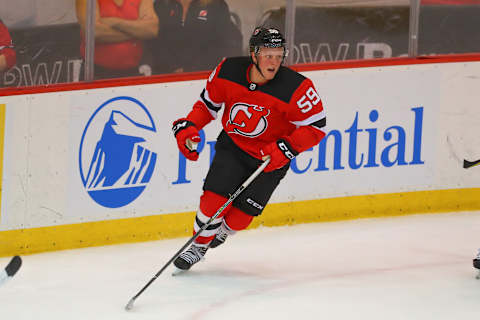
10. Fabian Zetterlund, RW [19] (3-63, 2017)
Stats (Farjestad BK, SHL): 35 gp, 3 g, 4 a, 7 p (6 pgp, 1 g, 1 a, 2 p); 8 gp, 2 g, 3 a, 5 p. Timra IK, Allsvenskan; 5 gp, 5 g, 1 a, 6 p (1 pgp, 0 g, 1 a, 1 p). Farjestad BK J20, SuperElit
Fabian Zetterlund is a good goal scorer who had a difficult time transitioning to the professional leagues, but he did so at 19. He’s still young and has time to perfect the shot that got him drafted in the third round. He’s good at possession, understanding how to best protect the puck, and keeps it on his stick. Zetterlund was better than a point per game in the SuperElit and was at a goal-per-game pace.
He’s still young and has time to perfect the shot that got him drafted in the third round
As a third-round pick, Zetterlund’s path to the NHL was always going to be a long one. He’ll need another year to settle into a role in Sweden, before making the trip across the ocean to the AHL. Zetterlund should continue to develop as a goal scorer, and he’s making progress as a playmaker as well. Being in Sweden should lead to a better defensive game, all of which he could bring along to the AHL.
He spent 35 games in the SHL and will likely spend more there this season. If he does better than seven points, that’s a very good sign. But he’s still a long ways off from the NHL, doesn’t have the highest likelihood of playing with the New Jersey Devils, and his ceiling has yet to be determined.
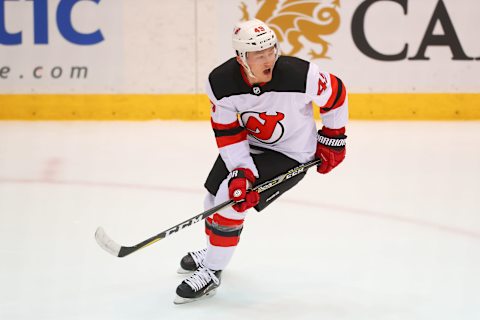
9. Joey Anderson, RW [20] (3-73, 2016)
Stats (University of Minnesota-Duluth, NCAA): 36 gp, 11 g, 16 a, 27 p, 4 PPG.
Not in the top 100 in any category, but Joey Anderson was a key part of the University of Minnesota at Duluth’s Frozen Four run. He’s a better playmaker than goal scorer, scoring just 11 goals and adding 16 assists. He was good on the power play, scoring four goals, and was just 19 and in his sophomore year. His Freshman season, Anderson scored 37 points including 12 goals. There should be hope in New Jersey that he gets back to that point.
Anderson was a key part of the University of Minnesota at Duluth’s Frozen Four run
Anderson will either make his AHL transition this season, hopefully playing with a goal scorer who can score on the chances he creates, or get back in the NCAA. Either way, Anderson should hopefully get more points this season. If he does, he sets himself up for a better future, and while he’s learning to gear his game around other things, playmaking should always be his first priority.
His ceiling in the NHL is likely a third-line playmaker. He’s got a while to go before being in the NHL on a consistent basis, and he also doesn’t have the highest likelihood of playing for the New Jersey Devils. But he’s closer than Zetterlund and better than other Devils prospects. Anderson just isn’t able to be higher on this list right now.
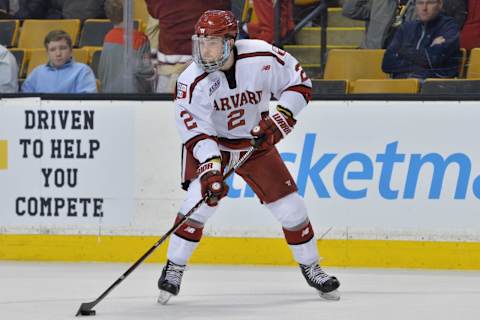
8. Reilly Walsh, D [19] (3-81, 2017)
Stats (Harvard University, NCAA): 33 gp, 7 g, 13 a, 20 p, 7 PPG, 2 GWG.
He was one of the best offensive defensemen, but it’s when you look at U20 defensemen that Reilly Walsh really stands out in the NCAA. Walsh was tied for 55th in defensive scoring but was 11th amongst U20 defensemen. He was tied for 27th in defensive goals but was fifth amongst U20. Tied for 83rd in assists, 12th in U20; 49th in points per game, ninth U20.
He’s shown significant promise as an offensive defenseman, but he’ll need to continue to grow his defensive game
Walsh was a significant part of Harvard’s run and will be a big part of their future. He’s likely headed back to the NCAA this season before making the professional transition to the AHL. He’s shown significant promise as an offensive defenseman, but he’ll need to continue to grow his defensive game. Walsh wasn’t good enough to earn a better spot on this list, but he’s clearly good enough to be on it.
With a better season next year, Walsh will be higher in the rankings for the New Jersey Devils. It’s just about proving that one season isn’t all that he has in him, something he should undoubtedly do.
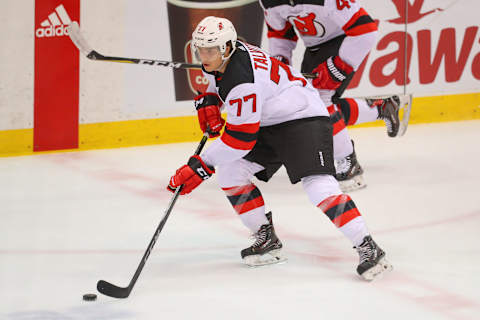
7. Aarne Talvitie, C [19] (6-160, 2017)
Stats (Blues U20, Jr. A SM-liiga): 41 gp, 34 g, 24 a, 58 p (3 pgp, 0 g, 1 a, 1 p).
Aarne Talvitie was one of the greatest players in the Jr. A SM-liiga this past season. He was tied for third in scoring and 27th in assists. He was first in goals and sixth in points per game. Talvitie is a natural goal scorer, one who is able to produce a great number of shots and get a good chunk of them in the net. Not bad for a sixth-round pick, and Talvitie has shown that he has better NHL potential than a lot of sixth-round picks.
Talvitie is a natural goal scorer, one who is able to produce a great number of shots and get a good chunk of them in the net
He was better than a point per game and he was nearly at a goal per game pace. Talvitie needs to prove that his goal scoring is able to translate to other leagues and to North America. He’ll need to play in a better league this season if he’s back in Finland, or he’ll need to show a lot of worth and shot production in the AHL if he comes to North America. He’s earned both opportunities, but another year of development in Finland might be better than forcing him into the AHL too soon.
Talvitie wasn’t as good in the playoffs, but that’s something he should be able to fix as he matures. His NHL ceiling could be a middle-six goal scorer. He’s still a few years away from consistent NHL time, and he doesn’t have a guaranteed chance of playing for the New Jersey Devils. But Talvitie has a ton of scoring talent.
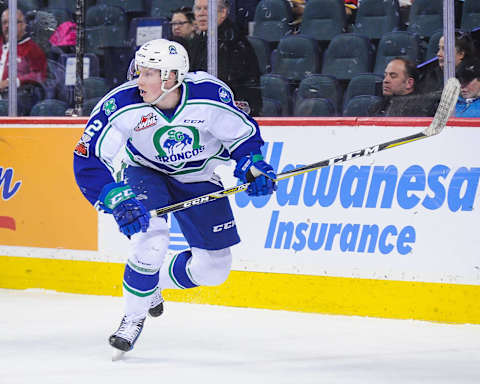
6. Colby Sissons, D [20] (UDFA)
Stats (Swift Current Broncos, WHL): 72 gp, 13 g, 58 a, 71 p, 5 PPG (27 A), 3 SHA, 2 GWG, 204 SOG, .99 pts/g (26 pgp, 5 g, 18 a, 23 p, 1 PPG (8 A), 2 GWG, 75 SOG, .88 pts/g).
One of the best offensive defensemen in the WHL and one who could be a factor for the New Jersey Devils in the coming years, Colby Sissons proved to be a dangerous weapon and one who should change New Jersey’s blueline. He had 32 points on the power play and scored eight even-strength goals. Sissons also produced at a 2.83 shots-per-game rate. He’s somebody who should be productive in the NHL.
Sissons proved to be a dangerous weapon and one who should change New Jersey’s blueline
Sissons somehow went undrafted in three straight drafts, but signing with the Devils could be a good thing for him. Without a ton of talent blocking him from the NHL, Sissons will have a clear shot once he proves capable at a professional level. Sissons was tied for third amongst defensemen in scoring in the WHL. He was tied for 11th in defensive goals and was fourth in assists amongst defensemen and eighth in points per game. In the playoffs, Sissons was first in defensive scoring, tied for second in goals, first in assists, and 13th in points per game.
Sissons was better than just ranking amongst defensemen. He was tied for tenth in playoff scoring and third in assists across the entire WHL. In the regular season, he was 11th in the WHL in assists and 46th in scoring. In the playoffs, Sissons continued to exhibit his strengths, getting nine points on the power play and producing at nearly a three shots-per-game pace.

5. Jeremy Davies, D [21] (7-192, 2016)
Stats (Northeastern University, NCAA): 36 gp, 6 g, 29 a, 35 p, 3 PPG, 1 GWG.
T-51 scoring (T-5 defensemen), T-39 goals defensemen, T-16 assists (3rd defensemen), T-48 pts/g (T-5 defensemen, 4 >2)
Jeremy Davies was one of the best offensive defensemen in the NCAA. That’s more impressive than Sissons because the NCAA is a better league than the WHL. Davies also played in one of the best NCAA conferences, which means he was facing better competition than Sissons. Davies is more of a playmaker than goal scorer, but he’s a defenseman. That’s what he’s supposed to do, set up plays for the forwards to convert. Create rebounds that go to the dirty areas, and then find ways to score goals when necessary. That’s where the three power-play goals come from.
Related Story. Top 25 Players Under 25. light
Davies was tied for fifth in scoring, fifth in points per game (though he was fourth with two or more games played) and was third amongst NCAA defensemen in assists. Northeastern has been one of the best teams at the collegiate level over the past few years, and Davies has been a significant part of that from the blueline. He scored eight goals and 23 points. Davies will try to help drive Northeastern further into the Frozen Four tournament next year.
Davies is a few years away from the NHL. He’ll need to prove himself in the AHL, and if that’s not this year then it is next year. He has a good chance of playing for the Devils if he continues to show promise as an offensive defenseman; if he continues to grow his game. He has a second-unit power play, top-six defenseman potential.
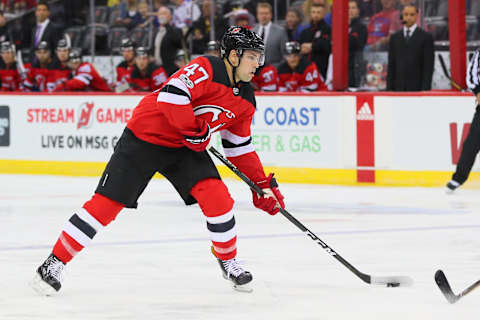
4. JohnQuenneville, C [22] (1-30, 2014)
Stats (Binghamton Devils, AHL): 43 gp, 14 g, 20 a, 34 p, 5 PPG (10 A), 118 SOG, .79 pts/g; 2 gp, 0 g, 0 a, 0 p. New Jersey Devils, NHL
The New Jersey Devils have a ton of patience with their first round picks. Besides Nico Hischier, first overall in 2017, the Devils have only had one first-round pick play consistently in recent years. That’s Pavel Zacha, whose ceiling has slowly lowered every season.
Maybe that’s why the Devils are having more patience with the prospects drafted in the first rounds before and after Zacha. This trend starts with John Quenneville, who should have finally earned a chance at the NHL with New Jersey.
Related Story. One Reason Each Team Should Be Excited Next Season. light
Quenneville scored 34 points in the AHL this past season in 43 games. 15 of those points came on the power play. He produced 2.74 shots per game and .79 points per game. He’s not a terrific goal scorer, he’s a good playmaker. His ceiling is a third-line player, one who should be good in the defensive zone, driving possession and getting the puck in the offensive zone for other players to score. He’s not the first line player the Devils might have hoped for, but Quenneville looks like an NHL player.
He’s got a very good chance of being a member of the New Jersey Devils, even if it’s in the bottom six. He’s NHL ready, more so than many prospects on this list, and while his ceiling isn’t as high, he still has a good amount of talent. It’s just time for that talent to be moved to the NHL so he can prove himself.
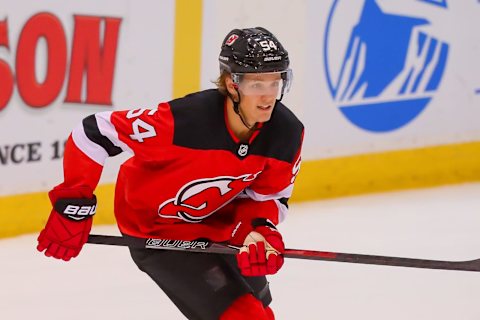
3. Jesper Boqvist, C [19] (2-36, 2017)
Stats (Brynas IF, SHL): 23 gp, 3 g, 10 a, 13 p, 1 GWG (8 pgp, 0 g, 1 a, 1 p); 4 gp, 0 g, 5 a, 5 p. Brynas IF J20, SuperElit
Jesper Boqvist is a much better player than some may realize. He impressed in training camp and development camp last year before playing in one of the best leagues in the world. Boqvist has a lot of speed and a lot of talent, and while he needs to work on his goal scoring, Boqvist has a lot else to offer.
He’s got creative vision, hockey IQ, and passing ability which allows him to be a good playmaker. He was sixth amongst players under 20 in the SHL in assists. He was tied for third in points per game in that group and was 10th in scoring.
Related Story. Greatest NHL Players to Wear Each Number. light
Boqvist was better than a point-per-game in the SuperElit last season, although he didn’t score a goal in four games. He really needs to work on his shooting and on his shot production this next season, wherever he is. Boqvist already has a game in the Swedish Hockey League this season, which may mean he’s back there full-time. If so, he knows what the New Jersey Devils are looking for and should be using his speed to create chances for himself.
After this season, Boqvist should move to the AHL and try to impress there. He’s got top-six potential, especially if he learns how to be a better goal scorer, and he could complement Hischier, Taylor Hall, or Jesper Bratt well. His speed should lead to a dangerous two-way game and to a good possession game. Even if he stays a dangerous playmaker without developing his shooting game, that’s still a weapon for the Devils.

2. Michael McLeod, C [20] (1-12, 2016)
Stats (Mississauga Steelheads, OHL): 38 gp, 16 g, 28 a, 44 p, 5 PPG (5 A), 2 SHG (1 A), 2 GWG, 120 SOG, 64.7 FO%, 1.16 pts/g (6 pgp, 6 g, 4 a, 10 p, 1 PPA, 1 SHG (1 A), 21 SOG, 63 FO%, 1.67 pts/g); 6 gp, 0 g, 1 a, 1 p. Binghamton Devils, AHL
Michael McLeod has come along way from being drafted 12th in 2016. Last season, in his first post-draft season, McLeod scored 73 points in 57 games. He added 27 points in 20 playoff games. This season, McLeod scored 44 points in 38 games, on track to do about the same. In the playoffs, McLeod scored 10 points in six games. That’s a better point-per-game pace. He’s growing his offensive game, even if he can’t stay healthy.
Related Story. Each Team's Worst Contract. light
That might be the biggest obstacle McLeod has to playing with the New Jersey Devils. His health is what has limited him from playing in the NHL so far, and the Devils have been waiting to see if he can stay healthy. It’s clear that McLeod can’t, even though he is massively talented. If he ever can stay healthy, McLeod could provide a long-term second punch to Hischier’s first one. McLeod has top-six center potential and has continually shown it in the OHL. He was tied for 24th in points per game this past season in an incredibly short campaign. He was second in points per game in the playoffs. In just six games, McLeod was also tied for 24th in playoff goal scoring.
McLeod is great as a goal scorer and great as a playmaker. He does everything right in the offensive zone. He should be a great offensive player for the New Jersey Devils in the near future. He’ll make the AHL transition this year and will be NHL ready sooner rather than later. He’s got all the talent in the world. What holds him back is his health. If McLeod can play 60 games in the AHL this season, he’ll be in the NHL next year. He’ll be ready for it.
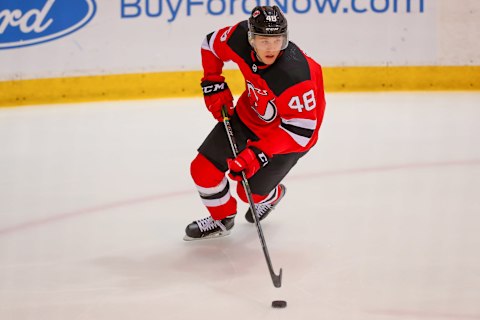
1. Ty Smith, D [18] (1-17, 2018)
Stats (Spokane Chiefs, WHL): 69 gp, 14 g, 59 a, 73 p, 3 PPG (24 A), 2 SHA, 4 GWG, 194 SOG, 1.06 pts/g (7 pgp, 2 g, 5 a, 7 p, 3 PPA, 1 GWG, 31 SOG, 1.00 pts/g).
One of the best offensive defensemen in the 2018 draft, it’s a miracle that the New Jersey Devils were able to draft Ty Smith at 17th overall. Smith is a bit on the small side and needs to work on his defensive game, but he’s got natural instincts and has done solid work already. He’s a natural power-play quarterback and somebody who can drive possession, and he’ll fit the new look New Jersey Devils blueline, one that relies upon offensive defensemen paired with more defensive defensemen like Mirco Mueller.
Smith was second in defensive scoring in the WHL this past season. He was tied for sixth in defensive goal scoring, second in defensive assists, and was sixth amongst defensemen in points per game. Smith was tied for eighth in defensemen in points per game in the playoffs, 15th in defensive playoff scoring, 10th in goal scoring, and 15th in assists. Smith was better than a point per game in the Canadian juniors as an 18-year-old. That’s really all you need to know about Smith as an offensive presence from the blueline.
dark. Next. 3 Devils Who Must Step Up
Smith also produced 2.81 shots per game and 27 points on the power play. He scored four game-winning goals in the regular season and had another one in the playoffs when he increased his shot production. Smith was a driving force of the Spokane Chiefs, even with other players like Kailer Yamamoto around. Smith needs to develop as a defensive presence in the next few years, but he’s likely bound for the New Jersey Devils top pairing in the future.